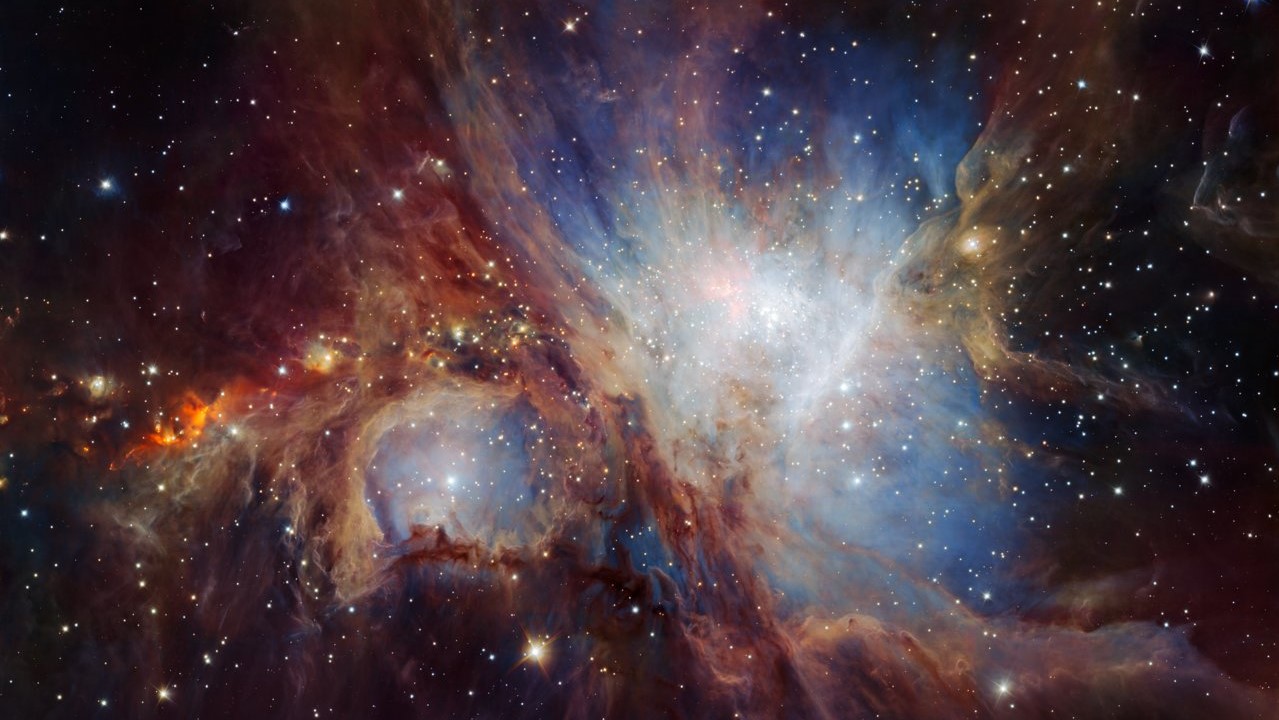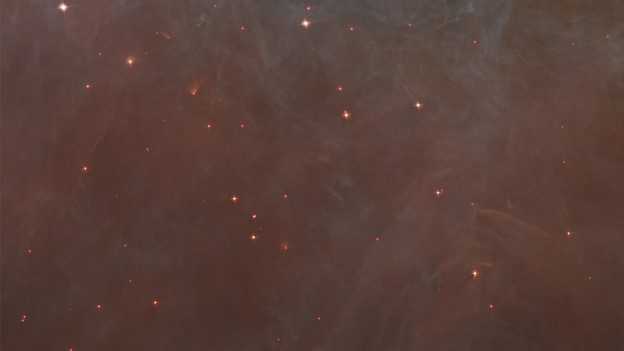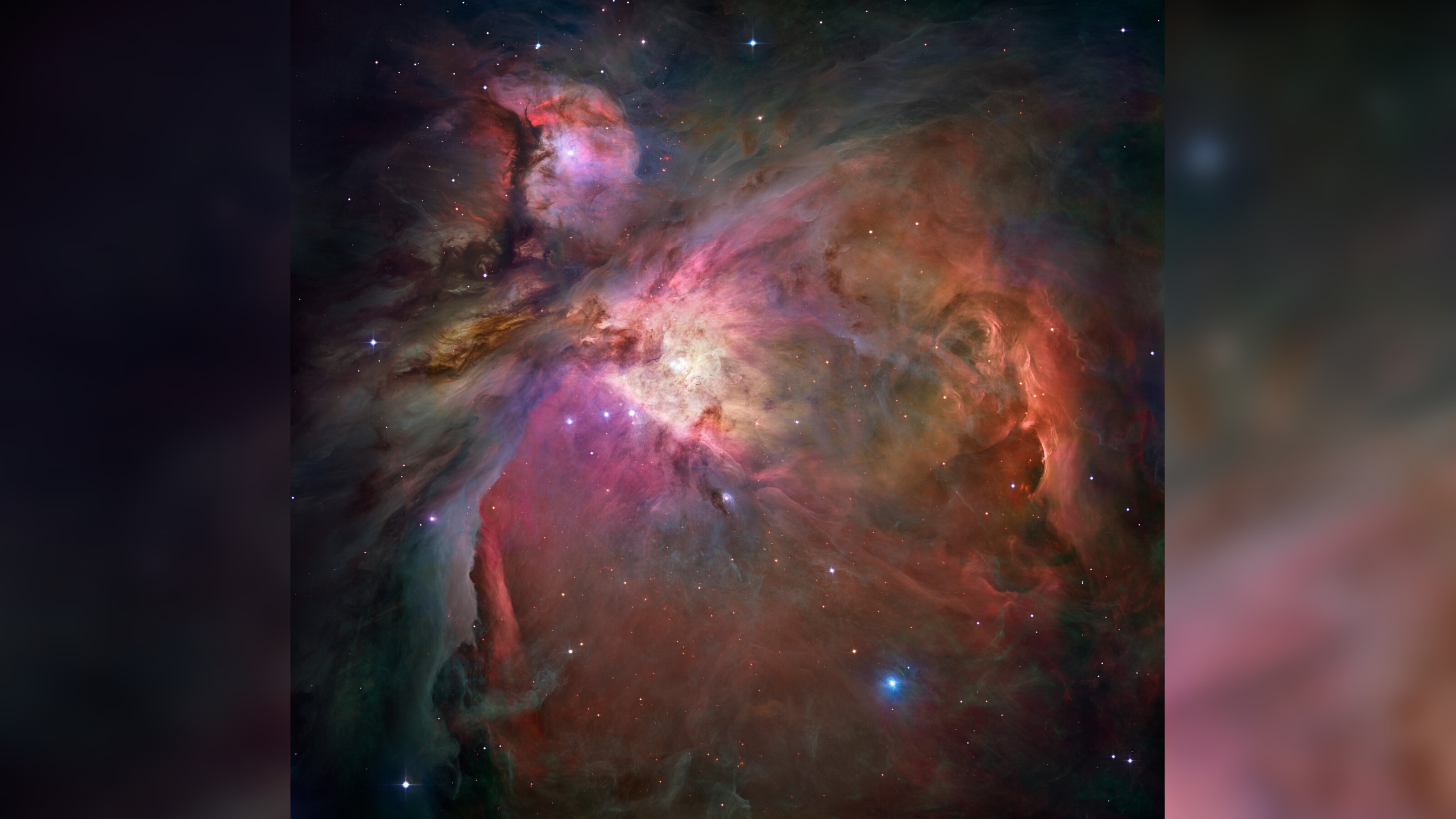Orion Nebula: Facts about Earth’s nearest stellar nursery
The Orion Nebula (Messier 42) is a popular target for astronomers and astrophotographers.

The Orion Nebula, also known as Messier 42 (or M42 for short), is the nearest star-forming region to Earth, located approximately 1,350 light-years away and is about 2 million years old according to NASA Jet Propulsion Laboratory. The billowing clouds of gas and dust are located in the Orion Constellation, just below Orion's Belt.
According to NASA, the majestic nebula can even be seen with the naked eye as it has an apparent magnitude of +4. The faintest object the human eye can see under the best conditions is +6 on the astronomical magnitude scale, according to Harvard University. It's, therefore, no surprise that the Orion Nebula has captivated civilizations around the world. For example, the ancient Maya of Mesoamerica interpreted the nebula as the cosmic fire of creation, according to NASA.
Astronomers believe the Orion Nebula generates enough water molecules to fill the Earth's oceans 60 times over, in just a single day, according to ESA.
The Orion Nebula is part of a larger stellar network — the Orion Molecular Cloud Complex (also known as the Orion Complex), one of the most active star-forming regions visible in the sky, according to the science communication website The Planets. According to researchers, the Orion Complex consists of several molecular clouds including the Lambda Orionis Clouds, the Orion A Cloud (which includes the Orion Nebula) and the Orion B Cloud (which includes the Flame Nebula), a complete list of Orion Complex nebulae can be found in a comprehensive paper published in the Astrophysical Journal.
Related: What's the story behind the stars?
Orion Nebula Evolution
The bustling stellar nursery is brimming with towering pillars of gas and dust that are home to fledgling stars. The entire scene is sculpted by stellar winds ejected by young stars that also emit powerful ultraviolet light.
In the central region of the Orion Nebula are four bright stars in an open star cluster known as the Trapezium due to their trapezoidal arrangement, according to NASA. These hot young stars emit ultraviolet light that carves through the core of the nebula, leaving large cavities void of the thick clouds of gas and dust. The large chasm carved by the Trapezium conveniently faces Earth, allowing observers to peer deep into the nebula's "heart" to view the rich tapestry of star formation within.
Object type: Diffuse emission nebula
Constellation: Orion
Apparent Magnitude: +4
Age: 2 million years
Coordinates: 05h 35m 17.3s (right ascension), -05° 23' 28" (declination)
Season: December through March (best in January)
Distance from Earth: 1,350 light-years
In 2006, the Hubble Space Telescope captured the sharpest view of the Orion Nebula ever seen, a stunning image revealing more than 3000 stars, some for the very first time, according to the European Space Agency. In 2016, the deepest and most comprehensive view of the Orion Nebula, revealed even more planet-mass objects and brown dwarfs, previously reported on Space.com.
Not all of the stars in the Orion Nebula are "successful." The Hubble Space Telescope has observed myriad brown dwarfs in the Orion Nebula. Brown dwarfs are sometimes referred to as 'failed' stars as they're too small to sustain nuclear fusion in their cores. According to NASA, brown dwarfs are not quite massive enough to be stars but are more massive than planets (between 13 and 80 times the mass of Jupiter.)

Observing the Orion Nebula
As the Orion Constellation is easy to locate and visible throughout the world from both the Northern and Southern Hemispheres, the Orion Nebula — nestled within the constellation — is a popular stargazing target for astronomers.
To find the Orion Nebula, you first need to locate the constellation Orion, then find Orion's Belt. Under Orion's Belt, are three dimmer stars that form Orion's sword, then in the middle of the sword is the Orion Nebula.
To the naked eye, the nebula appears as a fuzzy gray smudge under Orion's Belt. But with the help of a pair of binoculars or a telescope, you should be able to pick out more of Orion's distinguishing features including the bright central part of the nebula called the "Huygenian region" (named after the 17th-century astronomer Christiaan Huygens).
(Editor's note: If you're looking for a telescope or binoculars to observe the Orion Nebula, check our guide for the best binoculars deals and the best telescope deals now. If you need imaging gear, consider our best cameras for astrophotography and best lenses for astrophotography.)
With the right equipment and setup, astrophotographers can capture stunning images of the Orion Nebula that could rival even the Hubble Space Telescope, making the Orion Nebula a popular target for both stargazers and astrophotographers alike.
Related: Budget telescopes under $500: Picks from Celestron, Meade and Orion
More: Astrophotography for beginners: How to shoot the night sky
The Orion Nebula's many colors

In one of the most impressive images of the Orion Nebula, captured by the Hubble telescope, the different colors are attributed to different chemical elements. While the orange color can be attributed to hydrogen, the green to oxygen and the red representing both sulfur and infrared light observations, according to NASA.
Unlike Hubble, our eyes cannot distinguish the vibrant dues of the Orion Nebula. This is because our eyes contain two different kinds of photoreceptors — cones and rods. According to the Rochester Institute of Technology (RIT), cone cells are active at higher light levels and can perceive color whereas at low light levels rod cells sense light but cannot perceive color or fine details.
The Orion Nebula, therefore, appears as a gray smudge to most when viewed with the naked eye, with binoculars, or with a telescope. Though if conditions are right it is possible to see the blue-green hue emitted by oxygen ions in the Orion Nebula, according to lifestyle and entertainment magazine Jersey's Best. Some stargazers are fortunate enough to detect the green hues because the human eye is more sensitive to yellow-green light as opposed to red, according to Iowa State University, so if any color is to be detected from the Orion Nebula it is likely to be at the green end of the spectrum.
Though we may not be able to see all the impressive colors of the Orion Nebula directly, by using the right camera filters and image processing techniques, astrophotographers can produce visually stunning images of the Orion Nebula, awash with vibrant color. A good astrophotography guide for capturing a stunning image of the Orion Nebula can be found on the astrophotography website AstroBackyard. If you need help processing your images, check out our guide on the best photo editing apps for astrophotography.
The Orion Nebula through history
Our fascination with the Orion Nebula is not a recent phenomenon. Over the years, the spectacle has caught the attention of cultures around the world.
One civilization in particular where the Orion Constellation and nebula were an intrinsic part of their culture was the Maya. According to ecotourism website Mirador Park, the astronomical interpretations and mythological beliefs of inhabitants at sites such as El Mirador are reflected in the architecture found at the sites, particularly the astronomically-inspired "triadic pattern." An example of the importance of this triadic pattern within Maya life were the three hearth stones (or Ox Te Tun) found in every Maya Kitchen, according to Mirador Park. It is suggested that the three stones represent three stars in the Orion Constellation — Rigel, Alnitak and Saiph. The fire and smoke at the center of the hearth represent the Orion Nebula and were interpreted by the Maya as the cosmic fire of creation, according to NASA.
According to ESA, our sun was most likely born in a cloud similar to the Orion Nebula, 4.5 billion years ago.
The first observation of the Orion Nebula with a telescope was in 1610 by French scholar Nicolas-Claude Fabri de Peiresc according to the British Science Museum. The Orion Nebula was then independently observed in 1618 by Swiss astronomer Johann Baptist Cysat according to the science communication website The Planets.
As one of the brightest nebulas in the sky, it comes as no surprise that the Orion Nebula was the first nebula to be photographed. In 1880, Henry Draper captured the first image of the Orion Nebula, according to the American Institute of Physics and astrophotographers have been captivated by the Orion Nebula ever since.
Additional Resources
- Learn more about the Orion Nebula with this free course from the Open University.
- View one of the largest near-infrared high-resolution mosaics of the Orion A molecular cloud with the European Southern Observatory.
- Read about the supersonic “bullets” of gas in the Orion Nebula described by the NOIR Lab.
Join our Space Forums to keep talking space on the latest missions, night sky and more! And if you have a news tip, correction or comment, let us know at: community@space.com.
Get the Space.com Newsletter
Breaking space news, the latest updates on rocket launches, skywatching events and more!

Daisy Dobrijevic joined Space.com in February 2022 having previously worked for our sister publication All About Space magazine as a staff writer. Before joining us, Daisy completed an editorial internship with the BBC Sky at Night Magazine and worked at the National Space Centre in Leicester, U.K., where she enjoyed communicating space science to the public. In 2021, Daisy completed a PhD in plant physiology and also holds a Master's in Environmental Science, she is currently based in Nottingham, U.K. Daisy is passionate about all things space, with a penchant for solar activity and space weather. She has a strong interest in astrotourism and loves nothing more than a good northern lights chase!










